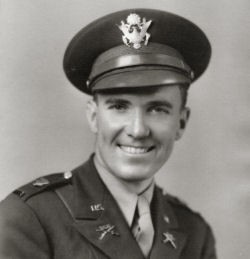|
Battles
Medals
Newspaper Clippings
358th Infantry Typed History from 9 July - 31 July 1944
Recommendation for Presidential Unit Citation for 3rd Bn, 358th Inf

|
Awards and Decorations
Awards and Decorations |
Date Awarded
|
Citation Text
|
Silver Star

|
25 August, 1944 |
Under the provisions of AR 600-45 and Circular 66, First United States Army, c s, the Silver Star is awarded to the following named Officer for gallantry in action in Northern France:
CAPTAIN ROBERT F. BURNS, 0384203, Inf, Headquarters 3rd Battalion, 358th Infantry, United States Army. On 12 July, 1944 near La Valaisserie, France, Capt Burns, battalion S-3, while forward, located the remnants of three rifle companies. Due to high losses the morale of the men was very low and they were completely disorganized. Capt Burns, working under heavy enemy fire, completely reorganized the remainder of these companies into a provisional unit and stayed in command until relieved by another battalion. Capt Burns' fearlessness and leadership under very difficult circumstances was in keeping with the highest traditions of the miliary service. Entered service from Chicago, Illinois.
By command of Brigadier General McLAIN. |
Bronze Star Medal

|
16 September, 1944 |
Under the provisions of AR-600-45 and Circular 6, Third United States Army, current series, The Bronze Star is awarded to the following named officer for meritorious service in action in Northern France:
CAPTAIN ROBERT F.BURNS, 0384203, Infantry, 358th Infantry, United States Army. From 1 August to 14 August 1944 between St Hilaire to Le Mans, France during a rapid advance and frequent fighting Captain Burns displayed energetic devotion to duty and initiative as operations officer of his battalion. He supervised movement of troops with little sleep and great fatigue against constant enemy resistance and harassment, thus enabling his battalion commander to meet critical situations. Entered service from Chicago, Illinois.
By command of Brigadier General McLAIN. |
Oak-Leaf Cluster to Bronze Star Medal

|
20 May, 1945 |
Under the provisions of AR 600-45 and Section I, Circular 6, Headquarters Third United States Army, 26 April 1944, in addition to Bronze Star previously awarded, an Oak-Leaf Cluster is awarded to:
Major (then captain and major) Robert F. Burns, 0384203, General Staff Corps, United States Army. For meritorious service in support of operations against the enemy in France, Luxembourg, Belgium, Germany and Czechoslavakia. During the period 15 August 1944 to 8 May 1945, Major Burns distinguished himself by the initiative, efficiency, and devotion to duty which he displayed as Assistant Chief of Staff, G-3, 90th Infantry Division. His meritorious service was in accordance with military tradition. Entered Military Service from Illinois.
BY COMMAND OF THE DIVISION COMMANDER. |
Combat Infantryman Badge

|
30 July, 1944 |
Under the provisions of WD Cir #188, dated 11 May 1944, a Combat Infantryman Badge is awarded the following named Officers and Enlisted Men for exemplary conduct in action against the enemy, effective 1 July 1944: 358th Infantry, 3d Bn: Capt Robert F. Burns |
Presidential
Unit Citation

|
24 February, 1945 |
Under the provisions of Section IV, Circular 333, War Department, 22 December 1943, and pursuant to the authority contained in the 4th Indorsement, Headquarters Third United States Army, File AG 2.6 (5 November 1944) GHMCA-4, dated February 1945, the following unit is cited:
The Third Battalion, 358th Infantry is cited for extraordinary heroism in the face of the enemy in France. During the period 10-12 July 1944, the officers and men of this organization displayed great courage, endurance, and dogged determination in the attack through the Foret de Mont Castre, France. The position known as the "Mahlman Line" was part of the main enemy defensive line. It consisted of dug-in positions, cunningly camouflaged in the tangled underbrush, and other devices which utilized to the fullest the natural defensive qualities of the area. Despite repeated fierce enemy counterattacks, the Battalion drove relentlessly forward and eliminated a battalion of parachute infantry and a company of parachute engineers, both of which were part of the elite 5th German Parachute Division. By the end of the first day the Battalion Commander and 11 of the 17 Company officers were casualties but the attack had progressed to within 75 yards of the initial objective. The following day the remants of the three rifle companies, one of which had only 20 men, were reorganized into one composite company with a strength of 126 men and commanded by a Lieutenant. In a renewed charge, the depleted Battalion overran the objective, killed 40 enemy, captured 8 machine guns, bazookas, and mortars. On 12 July 1944 as it left the forest, the Battalion, retaining its aggressiveness, fought with exceptional daring and great skill and took successive objectives. The Battalion's break through the enemy's main positions contributed materially to the Division's advance. The inspiring leadership of its officers and the gallantry displayed by all ranks were in accordance with the highest military traditions.
By command of Maj. Gen. Rooks |
Campaign Stars

|
|
Normandy
Northern France
Ardennnes
Rhineland
Central Europe
|
|

